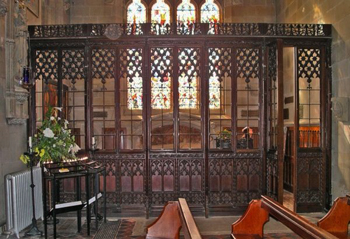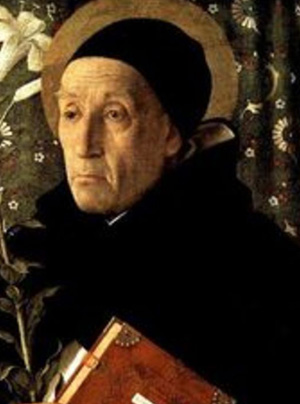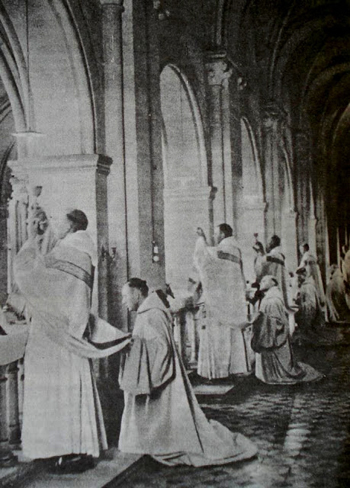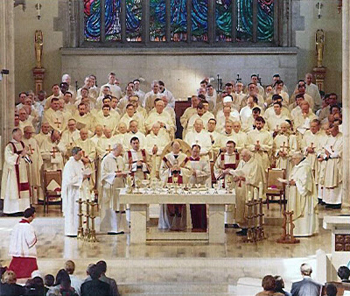Fabricated Charges against Chantries
Dr. Carol Byrne, Great Britain
As we saw in the last article, Fr. Josef Jungmann strongly objected to the pre-Vatican II chantry system. Jungmann contended that chantries were part of a “trend to the private and the subjective … since most of them were for private requests and had no public character.” (1)
In this, as in much else, he was mistaken. For, like all Masses, whether
celebrated in a monastery, parish church or special chapel, chantry
Masses were not private functions even if no one else happened to be
present besides the priest and a server. They were performed by a
chaplain in his public authority as a priest in the name of the whole
Church.

A parclose screen in a chantry chapel, allowing visibility
Apart from the theological aspect, it is obvious from a purely secular
angle that Jungmann’s assessment was misconceived, and we have to look
to the work of modern-day historians for a broader understanding and
appreciation of the chantry system. Dr. Simon Roffey, for example,
substantiating his conclusion with detailed documentary evidence, proved
that “far from being primarily individualist or indeed ‘private’
monuments, chantry chapels were in fact of great relevance to the wider
community.” (2)
Further in his book, the scholar asserts: “Though chantries and chapels
were founded and managed by individuals or by specific collectives, they
were very much public monuments and an important feature in communal
piety …[they] actively promoted inclusivity and communal participation
and greatly embellished, enhanced and encouraged parish church religious
practice.” (3)
Their public character is placed beyond doubt by Roffey’s analysis of
the topographical arrangement of the chantry chapels. He showed how they
were freely accessed from public areas of the church, such as the nave
or aisles. Even though some were sectioned off by a screen, (4) this
was decorated with openwork tracery in a manner that allowed visibility
from the nave. The people, therefore, were not excluded, even visually,
from being present at Mass.
Denying the benefits of many Masses
In order to bolster his opposition to the multiplication of Masses,
Jungmann made use of the medieval theologian, Meister Eckhart, whom he
quoted as saying that “neither blessedness nor perfection consist in
saying or hearing a lot of Masses.” (5) As he did not, however, give a
context or an original reference for this quote, which is certainly
incomplete, it cannot be taken at face value. (6)

Meister Eckhart, 28 propositions condemned as heretical or with flavor of heresy
But, more to the point, Eckhart was hardly an authority on Catholic
doctrine; he was brought before the Inquisition in 1326 on the charge of
preaching unorthodox doctrines and causing confusion especially among
the simple faithful. It is noteworthy that Jungmann failed to mention
that 28 of Eckhart’s propositions were condemned ‒ 17 of them as
heretical, and 11 savoring of heresy ‒ by Pope John XXII in 1329 in the
Bull
In agro Dominico.
We have it on the authority of St. Thomas Aquinas that “with several
Masses, the offering of the sacrifice is multiplied, and, therefore, the
effects of the Sacrament and the Sacrifice are also multiplied.” (7)
How spiritually well-served the medieval faithful were can be gauged
from the multiplication of Masses in the cathedrals, monasteries and
large churches, where several daily Masses were celebrated
simultaneously every hour of the morning. This means that, no matter how
early or late the faithful arrived, there would always be a Mass in
progress for them to attend.
A typical example is Lincoln Cathedral whose surviving records show that
in 1531 about 5 Masses per hour were celebrated simultaneously by the
chantry priests from 5 a.m. to 11 a.m. (“from the striking of the fifth
hour (ab hora quinta signata) to the eleventh”), with each
priest saying his own Mass at a designated side altar. (8) That
amounts to about 30 Masses per day within the walls of one church.
If we extrapolate from the above figures over the course of a year, the
number of Masses would have increased exponentially; and from there in
all the Catholic churches over the whole world down to our day, the sum
total of graces bestowed on the human race through the Mass would be
incalculable.
This pertained in the Church up until the post-Vatican II years (9)
when it was replaced by the widespread practice of concelebration, which
drastically reduced the numbers of individual Masses said throughout
the world and, consequently, the amount of grace available through them
to mankind, living and dead.
Jungmann trod in the steps of Luther
But Jungmann and, with him, the members of the Liturgical Movement who were his disciples, eschewed the traditional position:
“Today in the church that is constructed logically for the corporate
celebration of Mass by the whole congregation, the side altars disappear
and the church is built as a unified space where all eyes are directed
to the one altar upon which the sacrifice is corporately offered, the
one meal prepared for all.” (10)
Here we can see the original ground plan of our modern church
architecture and liturgical practices, which have swept away centuries
of ongoing, authentic Catholic Tradition. The idea of eliminating side
altars was originally Luther’s, as was the concept of the Mass as a
community meal at which all present are meant to eat and drink.
In 1533, Luther published an attack on the Mass and the Priesthood in
which he called especially for the abolition of private Masses said at
side chapels. (11) In it, he referred derisively to the private Mass
said without a congregation as a “Winckelmesse,” literally a whispered Mass-in-a-corner.

Multiple Masses said at side chapels eliminated, replaced by concelebration, below
 We can see how the same anti-Catholic prejudice has resurfaced in the
mainstream Church via the Liturgical Movement. According to Jungmann,
the custom of the side altar was an “obstacle in the way of a truly
corporate divine worship” and was one of the causes alleged by the
Pseudo-Reformation because it had led to a sense of loss of the Church
as a “community.” (12)
We can see how the same anti-Catholic prejudice has resurfaced in the
mainstream Church via the Liturgical Movement. According to Jungmann,
the custom of the side altar was an “obstacle in the way of a truly
corporate divine worship” and was one of the causes alleged by the
Pseudo-Reformation because it had led to a sense of loss of the Church
as a “community.” (12)
Thus, Jungmann can be said to have joined the ranks of those condemned
by Pope Pius X in 1907 who “feel no horror at following in the footsteps
of Luther.” (13)
Scorn of the Low Mass (14)
Jungmann criticized the Low Mass when it was said without people
present, but he did the same even when it was attended by large
congregations.
First, he found it too elitist: “Only the priest is permitted
to enter the sanctuary to offer the sacrifice. He begins from now on to
say the prayers of the Canon in a low voice and the altar becomes
farther and farther removed from the people into the rear of the apse.
In some measure, the idea of a holy people who are as close to God as
the priest is, has become lost. The Church begins to be represented
chiefly by the clergy. The corporate character of public worship, so
meaningful for early Christianity, begins to crumble at its foundations.
(15)
The clear implication here is that there is no distinction between the
priest and the people in the offering of the Mass, and that the lex orandi,
which gave a privileged place to the clergy was unjust and domineering.
Consequently, a reform would be needed to restore the “rights” of the
laity.
Second, he accused the “silent” Low Mass of being an obstacle
to true participation by the laity. In his opinion, it led to “the
estrangement of those who attended Mass without really taking part in
it,” (16) with the result that “the Mass is looked upon as a holy
drama, a play performed before the eyes of the participants.” (17) The
expression “dumb spectators” springs to mind.
These complaints raise theological issues about the identity of the
Catholic priesthood, at the very heart of which lies the meaning of the
Mass. It is that issue which, first, the 16th century Protestants and,
then, the 20th century liturgical progressivists aimed to destroy. And
the same complaints have been acting ever since as a corrosive acid
eating away at our Catholic institutions, values and identity.
To be continued
- Josef Jungmann, Mass of the Roman Rite, vol. 1, p. 131.
Jungmann defined the private Mass as “a Mass celebrated for its own
sake, with no thought of anyone participating, a Mass where only the
prescribed server is in attendance or even where no one is present, as
was the case with the missa solitaria”. (Ibid. p. 215)
- Simon Roffey, The Medieval Chantry Chapel: An Archaeology, Boydell Press, 2007, p. 6.
- Ibid. pp. 160-161.
- In architectural terms, this was called a parclose screen and was
often intricately carved with fine trellis work, leaving plenty of open
spaces for visibility from the main body of the church.
- J. Jungmann, Mass of the Roman Rite, vol. 1, p. 131, note
25. Johannes Eckhart (c. 1260-c. 1328), popularly known as Meister
Eckhart, was a German Dominican theologian, preacher and mystic. He was
well known for criticizing “Pharisaical” external actions not performed
with the right inner disposition, i.e. out of love of God. It seems that
this essential condition for gaining merit from the performance of good
works (such as saying or hearing Mass) was missing from Jungmann’s
quote.
- We are not given direct access to the original quote attributed to
Meister Eckhart. Jungmann reproduced it from Adolph Franz, who in turn
took it from a 19th century historian, Anton Linsenmayer, Geschichte der Predigt in Deutschland (History
of Preaching in Germany). (Munich, 1886, p. 408) It is evident that
Jungmann suppressed the context that Franz had given, namely Eckhart’s
insistence that outward observance alone is insufficient: “alle
äusseren Übungen nicht Selbstzweck, sondern nur Mittel zur Erreichung
des höchsten Zieles, der Vereinigung mit Gott durch Jesus Christus,
seien.” (all outer exercises are not ends in themselves, but a
means to achieve the highest goal, the union with God through Jesus
Christ) See A. Franz, Die Messe im Deutschen Mittelalter (The Mass in Medieval Germany), Freiburg, Herder, 1902, p. 298.
- St. Thomas Aquinas, Summa Theologica, Part III, q. 79, a. 7, ad. 3.
- R.E.G. Cole (ed.), Chapter Acts of the Cathedral Church of St Mary of Lincoln A.D. 1520-1536 ,
Publications of the Lincoln Record Society, 1915, pp. 142-144. These
records show that, in addition, there was Mass at the altar of the
Blessed Virgin Mary, High Mass at the main altar at 11 a.m. and another
chantry Mass at a side altar later in the morning.
- Pre-Vatican II Catholics will recall that in any large town or city
where there was a cathedral, monastery or house of a religious order of
priests, Masses were available throughout the morning starting from
about 5 a.m., and that they were generally well attended by people on
their way to work, by mothers who had taken their children to school, by
the retired and elderly and by passing visitors.
- J. Jungmann, Announcing the Word of God, translated from the German by Ronald Walls, London: Burns and Oates, 1967, p. 118.
- Martin Luther, Von der Winckelmesse und Pfaffen Weihe (Of
the Corner Mass and Ordained Priests), Wittenberg: Nickel Schirlentz,
1533. The first few pages of the book take the form of a dialogue which
Luther stated he had with the Devil. In it, according to Luther, the
Devil persuaded him to give up saying Mass on the grounds that it was an
idolatrous service. But the illogicality of calling the Mass a form of
idolatry did not strike Luther. As idolatry is Devil’s worship, why
should Satan recommend abolishing it? And, as Prince of this world, why
should he want to destroy his own Empire? It was Scripture, not Satan,
which condemned idolatry: “Wherefore, my dearly beloved, flee from
idolatry.” (1 Corinthians 10:14)
- J. Jungmann, “The Defeat of Teutonic Arianism and the Revolution of Religious Culture in the Early Middle Ages,” Pastoral Liturgy, New York: Herder and Herder, 1962, pp. 68, 79. Jungmann’s essay was originally written in 1947 and was reproduced in Pastoral Liturgy, 1962.
- Pius X, Pascendi, 1907, § 18.
- The Low Mass was sometimes referred to as Missa Privata, but the word privata
(Latin for “deprived”) simply meant that this form of Mass, while still
retaining its sense of mystery and its quintessentially Catholic
nature, lacked certain ceremonies found in the High Mass. In the rubrics
of the Low Mass, everything is recited by the priest and the responses
are made by the server; there is no role for the deacon, sub-deacon or
choir; incense is not used and there are only two candles. Under the
influence of the Liturgical Movement, the silent lay people attending at
Mass were encouraged to speak aloud and sing the responses at Low Mass
well before Vatican II.
- J. Jungmann, “The Defeat of Teutonic Arianism and the Revolution of Religious Culture in the Early Middle Ages,” p. 60.
- J. Jungmann, Mass of the Roman Rite, vol. 1, p. 141.
- Ibid., p. 107.

A parclose screen in a chantry chapel, allowing visibility

Meister Eckhart, 28 propositions condemned as heretical or with flavor of heresy

Multiple Masses said at side chapels eliminated, replaced by concelebration, below

- Josef Jungmann, Mass of the Roman Rite, vol. 1, p. 131. Jungmann defined the private Mass as “a Mass celebrated for its own sake, with no thought of anyone participating, a Mass where only the prescribed server is in attendance or even where no one is present, as was the case with the missa solitaria”. (Ibid. p. 215)
- Simon Roffey, The Medieval Chantry Chapel: An Archaeology, Boydell Press, 2007, p. 6.
- Ibid. pp. 160-161.
- In architectural terms, this was called a parclose screen and was often intricately carved with fine trellis work, leaving plenty of open spaces for visibility from the main body of the church.
- J. Jungmann, Mass of the Roman Rite, vol. 1, p. 131, note 25. Johannes Eckhart (c. 1260-c. 1328), popularly known as Meister Eckhart, was a German Dominican theologian, preacher and mystic. He was well known for criticizing “Pharisaical” external actions not performed with the right inner disposition, i.e. out of love of God. It seems that this essential condition for gaining merit from the performance of good works (such as saying or hearing Mass) was missing from Jungmann’s quote.
- We are not given direct access to the original quote attributed to Meister Eckhart. Jungmann reproduced it from Adolph Franz, who in turn took it from a 19th century historian, Anton Linsenmayer, Geschichte der Predigt in Deutschland (History of Preaching in Germany). (Munich, 1886, p. 408) It is evident that Jungmann suppressed the context that Franz had given, namely Eckhart’s insistence that outward observance alone is insufficient: “alle äusseren Übungen nicht Selbstzweck, sondern nur Mittel zur Erreichung des höchsten Zieles, der Vereinigung mit Gott durch Jesus Christus, seien.” (all outer exercises are not ends in themselves, but a means to achieve the highest goal, the union with God through Jesus Christ) See A. Franz, Die Messe im Deutschen Mittelalter (The Mass in Medieval Germany), Freiburg, Herder, 1902, p. 298.
- St. Thomas Aquinas, Summa Theologica, Part III, q. 79, a. 7, ad. 3.
- R.E.G. Cole (ed.), Chapter Acts of the Cathedral Church of St Mary of Lincoln A.D. 1520-1536 , Publications of the Lincoln Record Society, 1915, pp. 142-144. These records show that, in addition, there was Mass at the altar of the Blessed Virgin Mary, High Mass at the main altar at 11 a.m. and another chantry Mass at a side altar later in the morning.
- Pre-Vatican II Catholics will recall that in any large town or city where there was a cathedral, monastery or house of a religious order of priests, Masses were available throughout the morning starting from about 5 a.m., and that they were generally well attended by people on their way to work, by mothers who had taken their children to school, by the retired and elderly and by passing visitors.
- J. Jungmann, Announcing the Word of God, translated from the German by Ronald Walls, London: Burns and Oates, 1967, p. 118.
- Martin Luther, Von der Winckelmesse und Pfaffen Weihe (Of the Corner Mass and Ordained Priests), Wittenberg: Nickel Schirlentz, 1533. The first few pages of the book take the form of a dialogue which Luther stated he had with the Devil. In it, according to Luther, the Devil persuaded him to give up saying Mass on the grounds that it was an idolatrous service. But the illogicality of calling the Mass a form of idolatry did not strike Luther. As idolatry is Devil’s worship, why should Satan recommend abolishing it? And, as Prince of this world, why should he want to destroy his own Empire? It was Scripture, not Satan, which condemned idolatry: “Wherefore, my dearly beloved, flee from idolatry.” (1 Corinthians 10:14)
- J. Jungmann, “The Defeat of Teutonic Arianism and the Revolution of Religious Culture in the Early Middle Ages,” Pastoral Liturgy, New York: Herder and Herder, 1962, pp. 68, 79. Jungmann’s essay was originally written in 1947 and was reproduced in Pastoral Liturgy, 1962.
- Pius X, Pascendi, 1907, § 18.
- The Low Mass was sometimes referred to as Missa Privata, but the word privata (Latin for “deprived”) simply meant that this form of Mass, while still retaining its sense of mystery and its quintessentially Catholic nature, lacked certain ceremonies found in the High Mass. In the rubrics of the Low Mass, everything is recited by the priest and the responses are made by the server; there is no role for the deacon, sub-deacon or choir; incense is not used and there are only two candles. Under the influence of the Liturgical Movement, the silent lay people attending at Mass were encouraged to speak aloud and sing the responses at Low Mass well before Vatican II.
- J. Jungmann, “The Defeat of Teutonic Arianism and the Revolution of Religious Culture in the Early Middle Ages,” p. 60.
- J. Jungmann, Mass of the Roman Rite, vol. 1, p. 141.
- Ibid., p. 107.

No comments:
Post a Comment